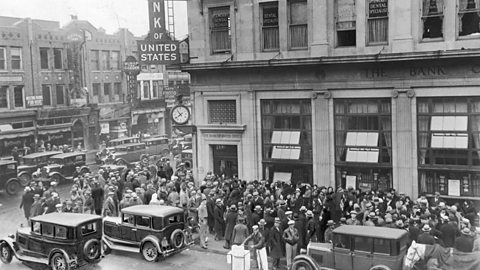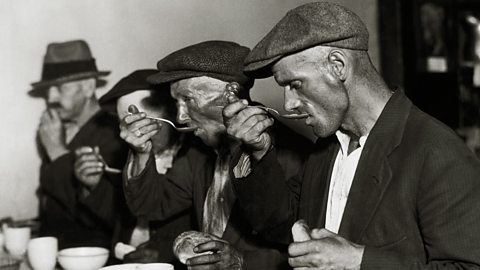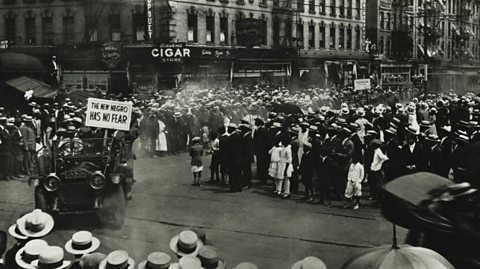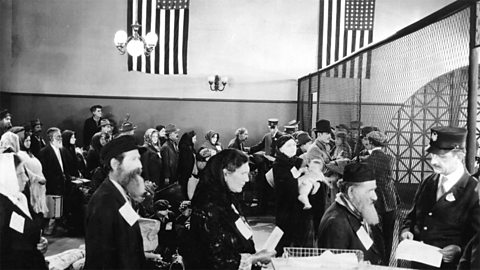Introduction

The economic prosperityBecoming well-off, or wealthy. of the 'Roaring Twenties' came to an end in October 1929.
On Black Tuesday, 29 October 1929, 16 million sharesA percentage of a business owned by a shareholder. were sold on the stock marketA centralised market where business shares are traded. in Wall Street and the economy collapsed completely.
By 1930, America was in the Great DepressionA global economic crisis that started in 1929 in the USA. It led to mass unemployment and hardship throughout the 1930s..
Long term reasons for the crash
Overproduction and underconsumption in agriculture
As farming techniques improved, farmers started producing more food.
However, the demand for grain fell in America because of ProhibitionA name given to a period in US history between 1920-1933 when alcohol was banned. and changes in tastes in food (less demand for wheat-based products).
There was also less demand from Europeans for American goods because they had placed tariffA tax or charge placed on imported or exported goods and services. on them and overproduction led to falling prices.
Thousands of farmers also had heavy debts as they had been encouraged to invest in new machinery and technology.
In 1924, 600,000 farmers lost their farms.
Overproduction and underconsumption of consumer goods
- By the end of the 1920s, there were too many consumer goodsProducts that individuals purchase for their own use or benefit. unsold in the USA.
- Mass production methods led to supply outstripping demand.
- People who could afford items such as cars had already purchased them.
- People in agriculture and the traditional industries, who were on low wages, could not afford consumer goods.
- Factories were losing money and forced to let go of workers, causing unemployment.
- This just repeated the cycle of a lack of demand.
Decline in traditional industries
- Coal mining, shipbuilding and railroads were either stagnant or in decline.
- Mechanisation also caused unemployment in these sectors.
Protectionism
- America tried to sell its surplusWhen there is more of something than is needed. goods in Europe.
- However, the Fordney-McCumber Tariff Act, 1922A US law which imposed taxes (tariffs) on goods from abroad in order to encourage people to buy American goods. had led to European countries imposing tariffA tax or charge placed on imported or exported goods and services. on American goods.
- This meant American goods were too expensive to buy in Europe, and as a result, businesses could not export their surplusWhen there is more of something than is needed. goods.
- There was, therefore, a decrease in trade between America and Europe.
Laissez-faire
- The laissez-faireA government policy of leaving something alone to sort itself out. 'Laissez- faire' is French for 'leave alone'. policy of the Republican Presidents (Harding, Coolidge and Hoover) meant there were not enough safeguards in the economy, especially on the banks and the stock marketA centralised market where business shares are traded..
- Banks were not regulatedSubject to control by means of rules and laws. and often loaned money recklessly, and they were not guaranteed to get it back.
- There were very few large banks in America, but there was a huge number of small ones which were unstable and did not have the financial resources to cope with the rush for money (as people tried to draw out their cash) when the Wall Street Crash happened.
- Many banks had already closed even before the crash, leaving thousands of customers with no money at all.
Increasing debt
- A lot of Americans bought goods on hire purchaseA method used to buy a product in instalments whereby the product only belongs to the person or business after the very last repayment..
- As a result, they owed money to shops and credit companies.
- Many of these businesses got into financial difficulties when people failed to pay their debts.
- House prices increased a great deal in the early 1920s.
- However, after 1926, house prices fell, leaving some Americans owning houses that were worth less money than what they had paid for them.
Speculation on the stock market
The government’s selling of war bondThis is a bond (debt) sold by the government to the public to fund military campaigns (such as both World Wars). These were presented as investment opportunities and a way for the public to demonstrate patriotism. during World War One meant ordinary people became attracted to investmentMoney or capital put into a business for profitable returns, for example interest or income..
Their interest continued in the 1920s, especially when they saw wealthy people making huge profits from buying and selling sharesA percentage of a business owned by a shareholder..
Shares are based on the value of a company. If the price of a share goes up, shareholders make a profit; if it goes down shareholders make a loss.
Attracted to the possibility of getting rich, shareholders often ignored the risk that they would make a loss.
Many Americans who could ill-afford to lose money became caught up in this disastrous type of speculationInvesting in stocks in the hope of making gains, but with the risk of making losses..
Some people even bought shares “on the margin”, i.e. they borrowed money to buy shares and then held on to them until they were worth more than the debt.
Between 1927 and 1929, there was a buying frenzy.
Almost 20 million Americans owned shares, pushing the value of shares up to unrealistic prices.
When the stock market crashed they were ruined.
Speculation on land
People also made vast profits speculatingTaking a risk in the hope that the price of shares will rise so profits can be made. on land, especially in Florida, and the price of land soared.
However, land values collapsed in 1926 and so did investors’ finances.
Short term triggers of collapse
The economy was very unstable before 1929, but it was events in that year which finally brought the 'Roaring Twenties' to an end.
Hoover’s election promise
- When Herbert Hoover became President in 1929, people thought he would increase
tariffA tax or charge placed on imported or exported goods and services. because he had promised to do this in the election campaign. - This boosted trading in shares on the stock marketA centralised market where business shares are traded. which pushed prices up further.
- When the US SenateA chamber of the United States Congress, which together with the House of Representatives, makes up the legislature of the United States. blocked Hoover’s plans on tariffs, people began selling their shares.
- This meant prices started to drop sharply.
Loss of confidence in the price of shares
- Experienced investorAn investor is a person who puts money (capital) into something with the expectation of a future financial return. knew the American economy was slowing down.
- If companies were struggling then their sharesA percentage of a business owned by a shareholder. price should not be so high.
- This meant that shares were overvalued.
- In September 1929, investors' lack of confidence in the price of shares meant they began selling them in large numbers.
- This caused prices to drop further.
Panic selling of shares, October 1929
By October, many more people started feeling nervous and panicked. They rushed to sell their sharesA percentage of a business owned by a shareholder..
On 24 October 1929, Black Thursday, 12.8 million shares were sold. Prices plummeted and the stock marketA centralised market where business shares are traded. began to crumble.
On 29 October 1929, Black Tuesday, the collapse of the economy was complete. 16 million shares were sold at a fraction of their price.
Thousands of people saw their fortune invested in shares, or any money they had in the bank, disappear.
Those who had bought on the marginA process where people borrow money in order to be able to buy shares. were in great trouble.
The stock market in New York had now collapsed.
The Wall Street Crash and its impact

The 'Roaring Twenties' came to a sudden end.
The unstable economy during the 1920s and the Wall Street Crash in 1929 led to an unprecedented economic depression in the USA.
The collapse of business
- Many of the businesses that had driven the economic boom went bankruptWhen an institution, organisation, company or person runs out of money..
- Between 1929 and 1932, 109,371 businesses failed and America’s Gross National Product (GNP)Total value of all the goods and services produced in a country in a year along with income from abroad. It is one way of measuring the wealth of a country. dropped by almost 50 per cent.
- Car production fell by 80 per cent and building construction by 92 per cent.
Loss of confidence in businesses
- The public lost confidence in the economy and hope in the future.
- They blamed big businesses and banks for the problems.
- Deaths by suicide went up 50 per cent.
- The stock market confidence was also low as people were now afraid to invest in it.
The collapse of the banks
- 659 banks closed in 1929.
- This increased to 2,294 in 1931.
- They collapsed because people withdrew their savings for fear of losing money.
- Their closures, in turn, led to the remainder of savers losing their cash as well.
- The biggest bank to close was the New York based Bank of the United States with 400,000 depositors losing their money.
- Those banks which remained refused loans to struggling firms, leading to even more bankruptWhen an institution, organisation, company or person runs out of money..
Debt
- Many people had bought sharesA percentage of a business owned by a shareholder. on the marginA process where people borrow money in order to be able to buy shares. hoping to pay off the debt through making a profit.
- The Wall Street Crash meant that they had lost their investmentMoney or capital put into a business for profitable returns, for example interest or income., but now also owed a debt.
- A lot of the consumer boom was based on hire purchaseA method used to buy a product in instalments whereby the product only belongs to the person or business after the very last repayment. agreements.
- These debts also had to be paid off.
Massive unemployment
- People could no longer buy consumer goods, such as cars and clothes.
- As a result, workers were made redundant.
- Unemployment rose to 25 per cent of the national workforce (14 million people).
- In some regions it was much higher.
- In Denora in Pennsylvania in March 1932, only 277 people out of nearly 14,000 had jobs.
- There was no work at all in the coal mines of Illinois.
- Unemployment and distress were highest among immigrants and black Americans.
±«Óătvlessness
- A lack of income meant that people were struggling to pay their mortgageA mortgage is a type of loan. It is usually a large amount of money used to pay for a property..
- In 1932 alone, over a quarter of a million people lost their homes.
- shanty townA spontaneous settlement. It is an illegal occupation of an area, where people often have to live without basic infrastructure, such as water, sewage, electricity and rubbish collection. sprang up in the cities due to the amount of homelessness.
- They were called "Hoovervilles", after President Herbert Hoover.
- There were over one and a half million vagrantA homeless, unemployed person who wanders from place to place. , called hobos, who lived rough and travelled across America, looking for any type of work.
Low wages and long hours for the employed
- Even those with jobs faced difficulties.
- Women, immigrants and black Americans had no choice but to work for longer hours for reduced pay.
- Wages dropped to starvation level.
- The average hourly wage in factories fell from 59 cents in 1926 to 44 cents in 1933.
Distress for farmers
- The plight of farmers, which was already distressing in the 1920s, deepened.
- A renewal of the USA’s tariffA tax or charge placed on imported or exported goods and services. war with other countries, because of the Hawley-Smoot Act, 1930US act which raised import duties in order to protect American businessmen and farmers., decreased their sales even further and evictions for non-payment of mortgageA mortgage is a type of loan. It is usually a large amount of money used to pay for a property. increased.
- Prices were so low that farmers left the crops to rot in the fields and farm animals were killed instead of being taken to market.
Quiz: Find the answer in the image
Test your knowledge
More on Life in the United States of America, 1920-33
Find out more by working through a topic
- count9 of 9

- count1 of 9

- count2 of 9

- count3 of 9
